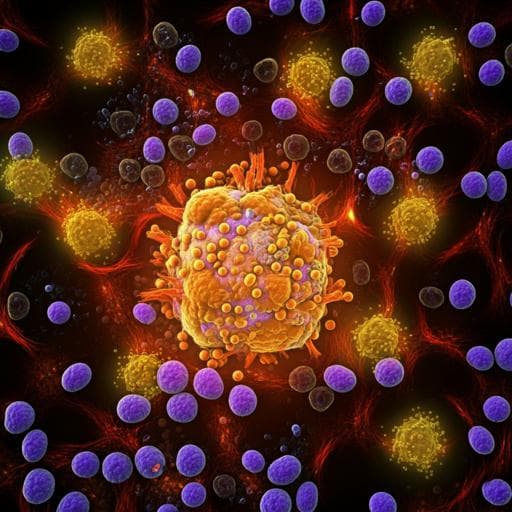
Medicine and Health
Met-Flow, a strategy for single-cell metabolic analysis highlights dynamic changes in immune subpopulations
P. J. Ahl, R. A. Hopkins, et al.
Discover how metabolic reprogramming influences the immune response of leukocytes! This innovative study introduces Met-Flow, a groundbreaking method developed by Patricia J. Ahl and colleagues that uncovers the metabolic states of immune cells, unlocking new insights into their functioning amid environmental changes.
~3 min • Beginner • English
Introduction
The metabolic state of immune cells fundamentally shapes their phenotype and function. Prior work shows glycolysis supports T cell effector function and cytokine production, while activation of naive T cells increases both glycolysis and oxidative phosphorylation (OXPHOS). Antigen-presenting cells require glycolysis, glycogen metabolism, and fatty-acid synthesis for stimulatory function, whereas regulatory fates can depend on fatty-acid synthesis or oxidation. These pathways are intertwined with signaling (e.g., mTOR) and post-transcriptional/post-translational regulation. Existing single-cell immune profiling (flow/mass cytometry, scRNAseq) and bulk metabolic assays are typically not integrated at the protein level for heterogeneous populations, limiting resolution of metabolic heterogeneity. The study proposes Met-Flow, a high-parameter flow cytometry approach measuring protein levels of key, rate-limiting enzymes/transporters across pathways to define the single-cell metabolic capacity. The research aims to determine whether metabolic protein profiles alone can resolve immune subsets, to characterize activation-induced metabolic remodeling, and to uncover subset-specific metabolic dependencies (e.g., under glucose restriction) that relate to effector functions.
Literature Review
The authors summarize evidence that: (1) glycolysis is central to T cell effector function and cytokine production; (2) activation increases both glycolysis and OXPHOS in naive T cells; (3) dendritic cell activation depends on glycolysis, glycogen metabolism, and fatty-acid synthesis; (4) regulatory T cells and tolerogenic dendritic cells utilize fatty-acid synthesis and oxidation, respectively, influenced by mTOR signaling measurable via phospho-proteins (PhosFlow). They note substantial post-transcriptional and post-translational regulation of metabolic enzymes, limiting mRNA-to-protein concordance and the ability of scRNAseq (even with hundreds of genes) to resolve metabolic states, whereas protein-level measurements can. Single-cell metabolic methods exist (e.g., autofluorescence for NAD(P)H, microfluidic lactate assays) but are single-modality and not integrated with immune phenotyping. This motivates a protein-level, multiplexed, single-cell immuno-metabolic approach.
Methodology
Study design and samples: Human PBMCs from healthy donors were isolated via Ficoll density centrifugation, cryopreserved, then thawed and cultured in complete RPMI. T cells were purified from PBMCs by magnetic selection (CD3 microbeads). Cells were rested and stimulated for 24 h with anti-CD3/CD28 beads (bead:cell 0.5:1) with or without 2 mM 2-fluoro-2-deoxyglucose (2-FDG) to inhibit glycolysis.
Met-Flow panel: A 27-parameter flow cytometry panel was developed including 10 metabolic proteins (rate-limiting enzymes/transporters): SLC20A1/PiT1 (phosphate transporter), ASS1 (arginine biosynthesis), SLC2A1/GLUT1 (glucose transporter), IDH2 (TCA/mitochondrial NADPH), G6PD (oxidative PPP), ACAC/ACACA (fatty-acid synthesis), PRDX2 (antioxidant), HK1 (glycolysis), CPT1A (fatty-acid oxidation), and ATP5A (ATP synthase/OXPHOS), plus lineage and activation markers to identify 11 leukocyte subsets. Antibodies were optimized, validated, and intracellular staining performed using Foxp3/Transcription Factor buffer set. Acquisition was on a BD FACSymphony; analysis in FlowJo.
Computational analysis: High-dimensional visualization used FitSNE on downsampled events per donor (PBMCs: 15,000 cells per leukocyte population; T cells: 10,000–20,000 per donor). Clustering was performed using either all phenotypic plus metabolic markers or only the 10 metabolic proteins to assess whether metabolic profiles alone define subsets. Heatmaps of geometric mean fluorescence intensity (gMFI) summarized protein levels across subsets. Correlations (Spearman) between metabolic proteins and immune phenotypes or activation markers were visualized by chord plots.
Activation and inhibition experiments: Purified T cells (focused on CD4+) were activated with anti-CD3/CD28. Effects of glycolytic inhibition were tested by adding 2-FDG alone or in combination with CD3/CD28. Activation markers (CD25, CD69, HLA-DR) and metabolic proteins were quantified by gMFI and correlations computed (e.g., GLUT1 vs CD25).
Memory subset analysis: CD4+ memory subsets (naive, TCM, TEM, TEMRA) were defined by CCR7 and CD45RA. Subset frequencies, metabolic protein levels, and activation markers were assessed under untreated, 2-FDG, CD3/CD28, and combination (CD3/CD28+2-FDG) conditions.
mTOR signaling: Phospho-S6 (Ser240/244) was incorporated to assess downstream mTORC1 signaling per cell and within memory subsets across treatments.
Cytokines and GM-CSF capture: Supernatants were analyzed by a 41-plex bead-based cytokine/chemokine assay. GM-CSF production was quantified at the single-cell level using a secretion/capture assay incorporated into Met-Flow, enabling linkage to memory phenotype and metabolic protein expression.
Extracellular flux (Seahorse): Glycolytic function (ECAR) and mitochondrial respiration (OCR) were measured in 200,000 cells/well after 24 h treatments using glycolytic and mitochondrial stress tests (glucose, oligomycin, 2-DG; oligomycin, FCCP, rotenone/antimycin A). Media contained glutamine and pyruvate with/without glucose as appropriate.
Statistics and reproducibility: Paired t tests or non-parametric ANOVA with multiple comparisons were used (GraphPad Prism). Significance thresholds P<0.05. PBMC clustering integrated n=12 samples across four experiments; activation analyses commonly included n=8 donors; respiration n=6 donors. scRNAseq public datasets (68k and 5k PBMCs) were reanalyzed for comparison of gene vs protein resolution.
Key Findings
- Met-Flow using only 10 metabolic proteins resolved major human PBMC subsets (CD3+ T cells, B cells, NK cells, mDCs, monocytes), comparable to scRNAseq using ~500 metabolic genes; the same 10 genes at RNA level could not resolve subsets.
- Distinct metabolic heterogeneity across leukocytes (gMFI): pDCs showed higher IDH2, ATP5A, G6PD, and GLUT1 than mDCs, indicating greater capacity for TCA/OXPHOS, PPP, and glucose uptake. Monocytes (CD16hi/lo) had high expression of most metabolic proteins; inflammatory CD16+ monocytes expressed higher G6PD, ACAC, and HK1 than CD16− monocytes. B cells exhibited higher GLUT1 and IDH2 than T and NK cells, consistent with activation requirements. NK subsets diverged: CD56bright cells had higher SLC20A1, ASS1, ACAC, HK1; CD56dim had higher CPT1A and GLUT1. NKT cells had higher IDH2, G6PD, ACAC, CPT1A, GLUT1 than CD4+ T cells. CD4+ vs CD8+ T cells had similar GLUT1 and HK1, but differed in G6PD (PPP capacity).
- T cell activation (anti-CD3/CD28) induced robust metabolic remodeling in CD4+ T cells: GLUT1 increased ~3-fold; IDH2, ACAC, G6PD, ASS1, PRDX2 increased >2-fold; HK1, ATP5A, CPT1A also significantly increased. Activation markers CD25, CD69, and HLA-DR increased (largest for CD25). In CD4+ vs CD8+ activation, CD4+ upregulated IDH2, ATP5A, and GLUT1 more, while CD8+ showed higher G6PD.
- Strong positive correlation between GLUT1 and CD25 with activation (Spearman r=0.8571, p=0.0107), linking glucose uptake capacity and IL-2 receptor expression; overlap of high GLUT1 and CD25 cells visualized by FitSNE.
- Glycolytic inhibition with 2-FDG alone for 24 h did not significantly decrease metabolic pathways. With CD3/CD28 activation, 2-FDG prevented the CD25 increase, while CD69 and HLA-DR were unchanged or increased. 2-FDG did not reduce GLUT1 levels (feedback maintenance), but reduced activation-induced increases of most other metabolic proteins to varying degrees, indicating partial glycolytic dependence.
- Cytokines/chemokines: CD3/CD28 increased multiple mediators (CCL3, IL-13, IL-6, sCD40L, IL-17A, TNF-α, IFN-γ, CXCL10). In the presence of 2-FDG, IL-13, IL-6, sCD40L, IL-17A decreased, whereas IL-8 and GM-CSF increased, indicating selective glycolytic dependence.
- Memory subset remodeling: Activation decreased naive CD4+ T cell frequency. Adding 2-FDG during activation (Combi) increased TCM frequency and reduced TEM and TEMRA. Within TCM, glycolytic inhibition attenuated activation-induced increases in HK1, GLUT1, CPT1A, IDH2, G6PD, ACAC, ATP5A, PRDX2, ASS1 and decreased CD25, but not CD69/HLA-DR. FitSNE showed a distinct immuno-metabolic cluster for the perturbed TCM subset.
- mTOR signaling (pS6): Activation increased pS6 across subsets (mean pS6+: naive 67%, TCM 69%, TEM 38%, TEMRA 36%). 2-FDG reduced pS6 in most cells except CD4+ TCM, which largely maintained pS6 positivity, suggesting reliance on non-glucose carbon sources.
- Extracellular flux: Activation increased basal glycolysis, glycolytic capacity and reserve (ECAR), and boosted basal/maximal respiration and spare respiratory capacity (OCR). 2-FDG reduced activation-induced glycolytic parameters but did not significantly reduce mitochondrial respiration at bulk level, implying alternative fuels.
- GM-CSF: CD3/CD28 increased GM-CSF production; with 2-FDG, GM-CSF production decreased in TEM and TEMRA but increased in TCM (and trend in naive). Under combi conditions, GM-CSF+ TCM exhibited higher metabolic protein expression (GLUT1, HK1, ACAC, ATP5A, ASS1, PRDX2) than other subsets, delineating a pro-inflammatory, glycolysis-independent TCM phenotype.
Discussion
Met-Flow provides a protein-level, single-cell view of metabolic capacity across immune subsets, linking metabolic heterogeneity to phenotype, activation, and effector function. The method resolves major leukocyte populations using metabolic proteins alone and highlights subset-specific pathway dependencies (e.g., heightened PPP in CD8+ T cells, oxidative bias in CD4+ T cells, distinct lipid metabolism in NK subsets, and divergent mDC/pDC programs). Activation-induced remodeling spans glycolysis, PPP, OXPHOS, fatty-acid synthesis/oxidation, antioxidant response, and arginine metabolism. The tight association between GLUT1 and CD25 underscores the coupling of glucose uptake and IL-2 signaling. Glycolytic inhibition reveals selective control of activation markers and cytokines and uncovers a TCM subset that maintains mTOR signaling (pS6), expands under glucose restriction, and produces GM-CSF despite reduced glycolytic flux. Bulk extracellular flux assays corroborate increased glycolytic and respiratory capacity with activation and show that OXPHOS can be maintained under glycolytic inhibition, consistent with the subset-level observation that TCM can utilize alternative carbon sources. Overall, Met-Flow exposes how metabolic programs shape immune function and identifies a metabolically distinct, pro-inflammatory TCM population with potential relevance to inflammatory disease and therapeutic targeting.
Conclusion
This work introduces Met-Flow, a high-dimensional flow cytometry platform that quantifies key metabolic proteins at single-cell resolution alongside immune phenotypes. Met-Flow resolves immune subsets by metabolic state, maps activation-driven metabolic remodeling, and links pathway dependencies to effector functions. It reveals a glycolysis-independent, GM-CSF–producing central memory T cell subset that expands under glucose restriction and maintains mTOR signaling, suggesting new avenues for targeting pathogenic immunity. Future directions include expanding the metabolic panel to additional biosynthetic pathways, integrating with other high-parameter modalities (e.g., Abseq, CyTOF), applying Met-Flow across diseases and tissues, and combining with flux/metabolite assays to fully define pathway usage and therapeutic vulnerabilities.
Limitations
Met-Flow measures protein levels of rate-limiting enzymes/transporters as a proxy for metabolic capacity but does not directly quantify metabolic flux; complementary assays (e.g., extracellular flux, metabolomics) are needed for pathway activity. Some protein expressions can be affected by sample handling; for example, the phosphate transporter SLC20A1 was diminished after T cell purification independent of stimulation, indicating that processing can alter certain metabolic markers. Findings were generated primarily in healthy donor PBMCs and purified T cells under in vitro stimulation, which may not fully capture in vivo tissue microenvironments or disease contexts.
Related Publications
Explore these studies to deepen your understanding of the subject.







